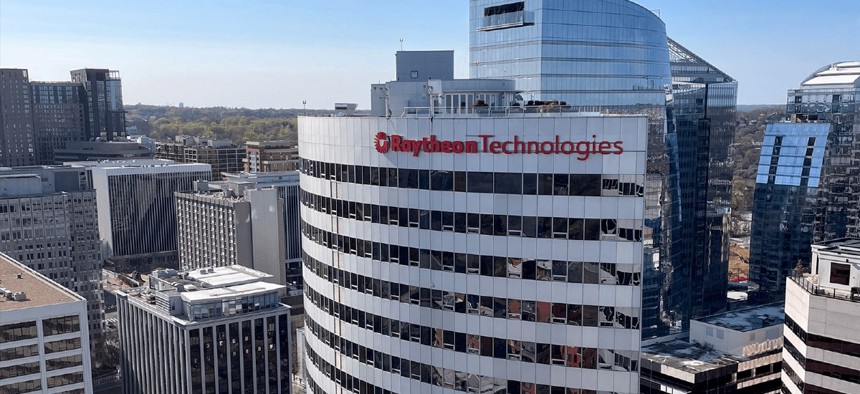The newly minted 'RTX' lays out its post-reorg blueprint

The Arlington, Virginia headquarters campus of RTX (with the now-former Raytheon Technologies signage). Courtesy of RTX.
With a new structure in place, the global aerospace-and-defense company highlighted its priorities that include the U.S. military's complicated network vision known as "JADC2."
Since the merger to create it in 2020: the company formerly known as Raytheon Technologies has had a lot of moving pieces both within itself and also without via a series of divestitures.
Now the global aerospace-and-defense giant calls itself by the three-letter acronym "RTX" that has both been its stock symbol for the past three years and unofficial nickname over that period. RTX will also become a three-segment company in a move scheduled to take effect July 1.
With that new framework soon to be in place, where is RTX looking to go next and how is the company working to reach the financial goals it wants to achieve for 2025?
Those were among the big-picture questions that RTX management gave some answers to during an investor day presentation held Monday at the Paris Air Show. Given what WT covers, we will focus on certain aspects of the Raytheon and Collins Aerospace business segments.
Arlington, Virginia-headquartered RTX ranked No. 6 on the 2023 Washington Technology Top 100 with approximately $5.4 billion in prime contract obligations.
Raytheon
Much of RTX's work for defense and government customers will reside in this segment being formed through a consolidation of RTX's missile and defense business unit with the intelligence and space division.
Raytheon touts having posted $25.2 billion in revenue for 2022, a sales figure arrived at after adjusting for the realignment. RTX's other two segments are Collins Aerospace — which houses the aviation technology and communications business lines — and the engine maker Pratt & Whitney.
Cyber continues to be a core leg of RTX's strategy as it was in the days of the former Raytheon Company prior to the merger that made RTX.
The cyber part of the business "is very focused on classified customers" in addition to other government agencies, Raytheon's segment president Wes Kremer told analysts at the Paris Air Show.
Kremer acknowledged the Raytheon space strategy as having gone through a couple of iterations, but has settled on this description he offered:
"Largely returning to our roots, which is our focus on exquisite payloads, working with the other primes to develop incredible capability that gets put on those systems, along with our strong ground processing capabilities. That's always been the core part of our space business."
Small satellites and electronics represent two other areas of interest for RTX with respect to its space pursuits. The company added greater footings there via these acquisitions Kremer highlighted: Blue Canyon Technologies and SEAKR Engineering.
Looking beyond space, the electronics market — and particularly semiconductors — have been a pain point for the entire government contracting industry that includes RTX. Computer chips that go into many subsystems that are part of larger platforms have been in short supply over the past few years.
While that chip supply crunch has eased some, Kremer said RTX expects the trend to accelerate even more in the second half of this year. RTX needs that to happen to because of how it builds many of the circuit cards.
"That factory that builds a lot of the circuit cards and stuff is at the front end, then it feeds all of our other factories," Kremer said. "That really is key for us. I would say that we're cautiously optimistic that the microelectronics will ease."
Collins Aerospace
This segment will lead RTX's pursuits of opportunities to perform work in support of JADC2 — the Defense Department's convoluted vision for connecting every soldier and system in the field across an overarching network architecture.
The Joint All-Domain Command and Control concept is also about having an open architecture, and therefore an open tent of companies, so that new information and communication technologies can be integrated as they evolve.
At $23 billion in adjusted revenue for 2022, Collins Aerospace is looking to move that needle upward by becoming a leader in the domain its president Steve Timms called "the connected battlespace" with JADC2 a key component of that.
"Today, a lot of our key assets always aren't as interoperable as they need to be, which means command decisions where you have to validate the intelligence — all the sensor information — bring it together, validate it and make a command decision that needs to happen in minutes and seconds," Timms told analysts. "So one of the things we're very focused on is how our solutions — because they require a more connected battlespace — are really going to bring a new level of interoperability."
Timms said RTX has identified $15 billion in JADC2 awards and demonstrations as part of its plan. One completed demonstration Timms highlighted saw RTX present directional communications with the intent to link together both U.S. and international partner networks.
RTX's idea there was to show how it could integrate command-and-control networks that previously could not interact with each other.
"Clearly this is a segment that's growing faster than the overall defense budgets here and one we're excited to lead," Timms said of JADC2.


